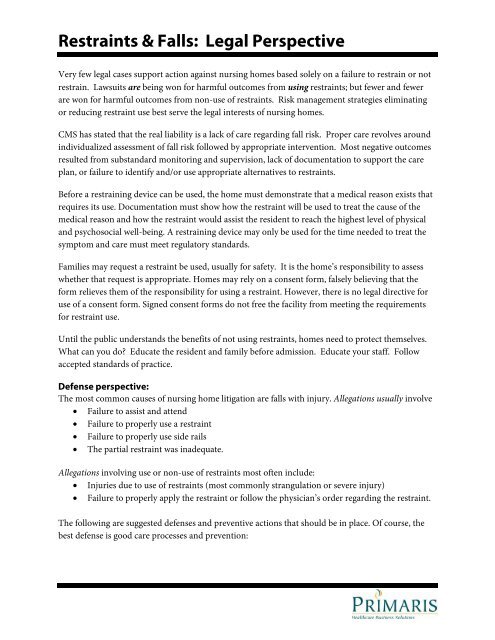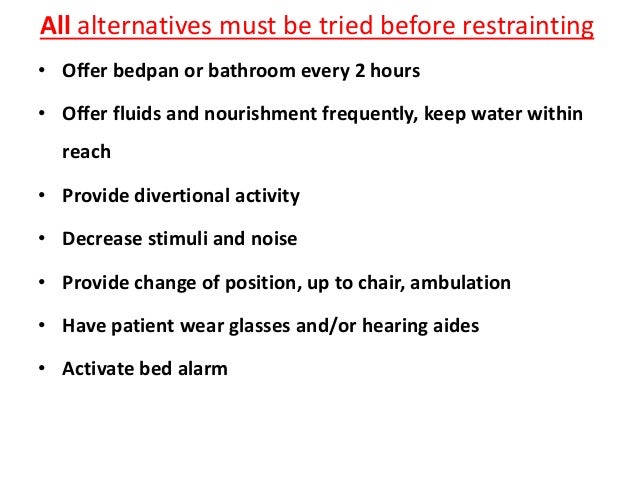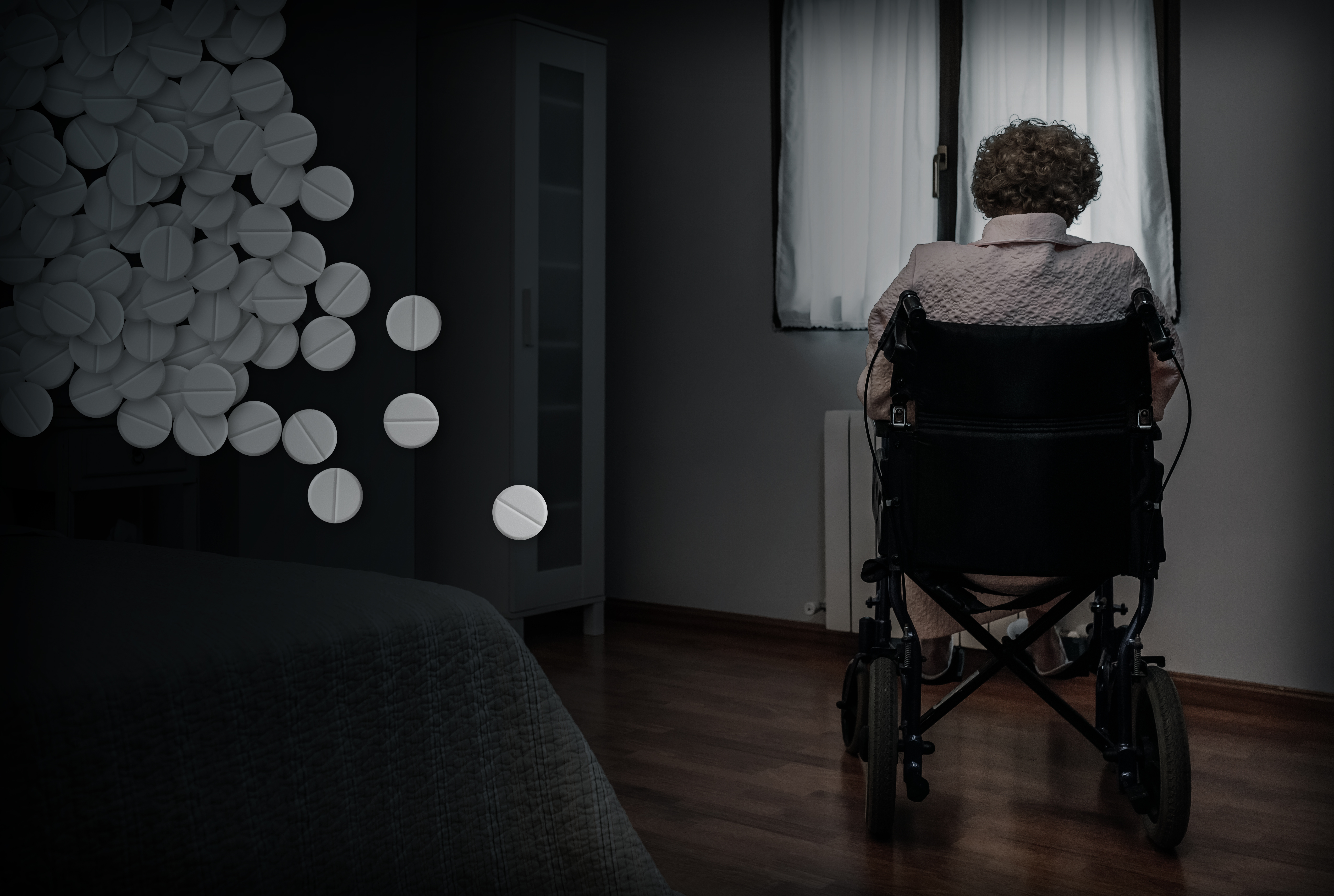Table of Content
- Preventing belt restraint use in newly admitted residents in nursing homes: a quasi-experimental study.
- Short-term effects of an educational intervention on physical restraint use: a cluster randomized trial
- A Clinical Trial to Reduce Restraints in Nursing Homes
- Trial registration
- Design and sample
- Process evaluation of a multicomponent intervention program (EXBELT) to reduce belt restraints in nursing homes.
Clipboard, Search History, and several other advanced features are temporarily unavailable.
Close attention to the person's comfort, safety and needs for hydration, elimination, exercise and social interaction is essential while the restraint is in use. Positive effects of resistance training in frail elderly patients with dementia after long-term physical restraint. Randomized multilevel intervention to improve outcomes of residents in nursing homes in need of improvement. Representatives of the nursing staffs, product developers, and the research team will discuss problem cases in a creative session. Agsjournals.onlinelibrary.wiley.com needs to review the security of your connection before proceeding. Onlinelibrary.wiley.com needs to review the security of your connection before proceeding.
Preventing belt restraint use in newly admitted residents in nursing homes: a quasi-experimental study.
The baseline rate of falls was lowest in the control nursing home but, after the interventions, this nursing home had a higher rate of falls than the other two nursing homes. A new multi-component intervention comprising an educational intervention for nursing home staff in combination with a policy change, availability of a nurse specialist and nursing home manager as consultants, and availability of alternative interventions is developed. To test the effects of a multicomponent intervention program to reduce the use of belt restraints in psychogeriatric nursing homes. Process evaluation of a multicomponent intervention program to reduce belt restraints in nursing homes.

The effects of a restraint minimization education program on staff knowledge and attitudes and use of physical restraints are evaluated. A quasi-experimental study is presented to investigate the effects of EXBELT on the use of belts on wards in psychogeriatric nursing homes. The study will be conducted in 26 wards in 13 psychogeriatric nursing homes.
Short-term effects of an educational intervention on physical restraint use: a cluster randomized trial
Use of vest restraints decreased by 41 percent in the nursing home that provided education sessions and by 77 percent in the nursing home that provided education and consultation. Geriatric chair use was not signficantly affected by any of the interventions. For years, physical restraints have been viewed as an appropriate intervention to prevent falls, to manage wandering and/or behavioral disturbances, or to minimize tampering with medical devices (intravenous lines, feeding tubes, indwelling bladder catheters, etc.). A mixed method study of an education intervention to reduce use of restraint and implement person-centered dementia care in nursing homes. In November 2008 the Medical Ethics Committee of the University Hospital Maastricht and Maastricht University has approved the study design and protocols. Representatives of the residents received written information and were asked to give written informed consent for the use of personal data on the residents in the study.

Furthermore, changing attitudes will become an important addition to the educational part of EXBELT. To participate, the prevalence of belt use on psychogeriatric nursing home wards had to be at least 10%. Wards are excluded if the unit is dedicated to residents with Korsakoff's, if far-reaching reorganizations and/or constructional renovations will be implemented, and if participating in other studies and/or projects aimed at the reduction of restrain use. The total study sample comprises four nursing home associations, 13 nursing homes with a total of 26 psychogeriatric wards. Assignment to either to intervention or control groups was carried out by the research team. Since no randomization took place, allocation was based on avoidance of contamination bias.
A Clinical Trial to Reduce Restraints in Nursing Homes
For instance, in the study by Huizing and colleagues it was reported that the availability of some new and rather expensive alternative measures was limited . Finally, there are indications that legislation influences the use of restraints; the success of the educational intervention in the USA has also been supported by a nursing home law that led to national nursing home regulations (OBRA '87) that discourage restraint use . In the Netherlands, the secretary of state of the Ministry of Health, Welfare and Sports in 2009 has introduced a bill in Parliament ("Wet Zorg en Dwang") that regulates the use of physical restraints in people with dementia in general and belts in particular. According to this bill, the usage of belts to prevent falls will no longer be allowed .
Data will be collected at baseline , and four and eight months after baseline. Predictors of continued physical restraint use in nursing home residents following restraint reduction efforts. Attitudes of relatives of nursing home residents toward physical restraints.
All interviews were conducted on site, one-on-one and face-to-face, using semi-structured interview protocols. Qualitative descriptive method was used and qualitative content analysis was employed. Semantic Scholar is a free, AI-powered research tool for scientific literature, based at the Allen Institute for AI. It is suggested that an APN consultation model can effectively be implemented through comprehensive, individualized assessment without incurring substantial costs to the nursing home. Use of restraint amongst institutionalised elderly with dementia and problem behaviour not only remains widespread, but also appears to be accepted as inevitable. One specific module focused on strategies for changing attitudes such as shifting perspectives .

A guideline- and theory-based multicomponent intervention compared with standard information reduced physical restraint use in nursing homes. Dementia Care Practice Recommendations for Assisted Living Residences and Nursing Homes is a guide for providing quality care to residents with dementia, and include recommendations for providing care without the use of physical restraints. Interventions for preventing and reducing the use of physical restraints in long-term geriatric care. The role of nursing administrators in reducing the use of physical restraints as part of a 2-year, national nursing home restraint-reduction project is described. To describe how removing physical restraints affected injuries in nursing home settings, physical restraints were removed in residential and social services settings and inpatient settings.
All authors critically reviewed the manuscript, read and approved the final manuscript. Before sharing sensitive information, make sure you’re on an official government site. Interventions for preventing falls in older people in care facilities and hospitals. The objective was to investigate restraint use and its associations with neuropsychiatric symptoms and personal characteristics in residential care. Before sharing sensitive information, make sure you’re on a federal government site. Forty registered nurse and geriatric care assistant informants participated in the first round of interviews and 16 of them participated in second confirmatory interviews.

The proposed changes in legislation provide an opportunity to develop a multi-component intervention tailored to the Dutch nursing home environment that will assist facilities in meeting this new requirement. The use of physical restraints still is common practice in the nursing home care. Since physical restraints have been shown to be an ineffective and sometimes even hazardous measure, interventions are needed to reduce their usage.
Barriers to reducing the use of restraints in residential elder care facilities. However, recent research has demonstrated that restraints do not prevent falls. In fact, people who are restrained still fall, and are more likely to be seriously injured if the fall occurs while restrained. And other methods for managing wandering, behavioral issues and interference with medical devices have been found to be more effective. Physical restraints should only be used in rare circumstances, and only as a short-term measure. Using a restraint should be the last resort, even when a justifiable medical indication is present.
Interventions for preventing and reducing the use of physical restraints of older people in general hospital settings. Comparability between the intervention and control groups will be assessed at baseline to check for differences between the two groups on socio-demographic characteristics . Outcomes at T2 and T3 will be compared between the intervention and control groups by both univariate and multivariate techniques.
The use of physical restraints still is common practice in the nursing home care of older people with dementia. Physical restraints are defined as any limitation in an individual's freedom of movement and includes those worn by the person (belt, chest, and arm/leg), those attached to beds (full-enclosure bedrails) or chairs . Although reports of restraint prevalence internationally varies from 15 to 66% , ranges of restraint prevalence in Dutch nursing homes is between 41 to 64% . Recent prevalence measures in the Netherlands have shown that 10% to 14% of nursing home residents are restrained with belts .

The six-month, 10-session restraint education program was taught by a gerontologic nurse specialist. The 30- to 40-minute sessions focused on the effects of physical restraints, the behavior of residents, ways to minimize the risk of falls and ways to cope with problem behaviors such as wandering and agitation. The consultations focused on residents who posed a challenge because of their behavior. The process evaluation will monitor the content and feasibility of the intervention program.



































